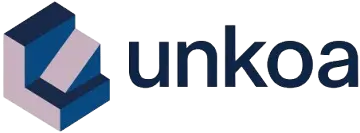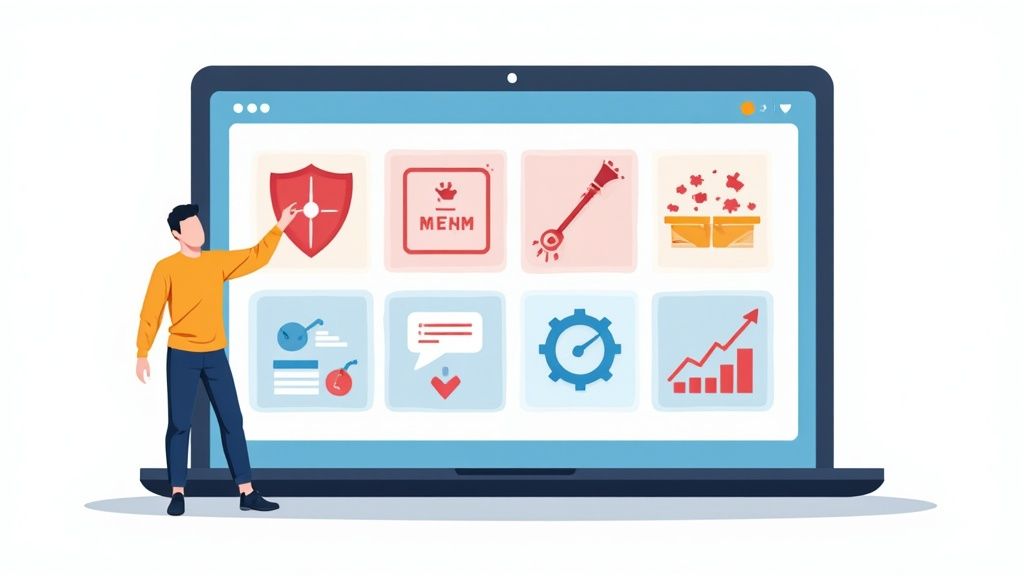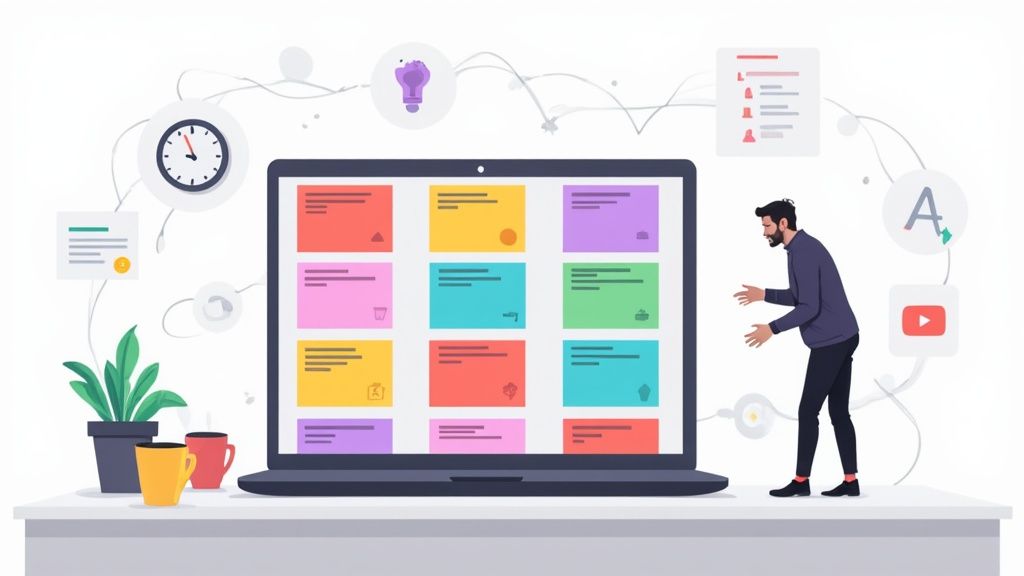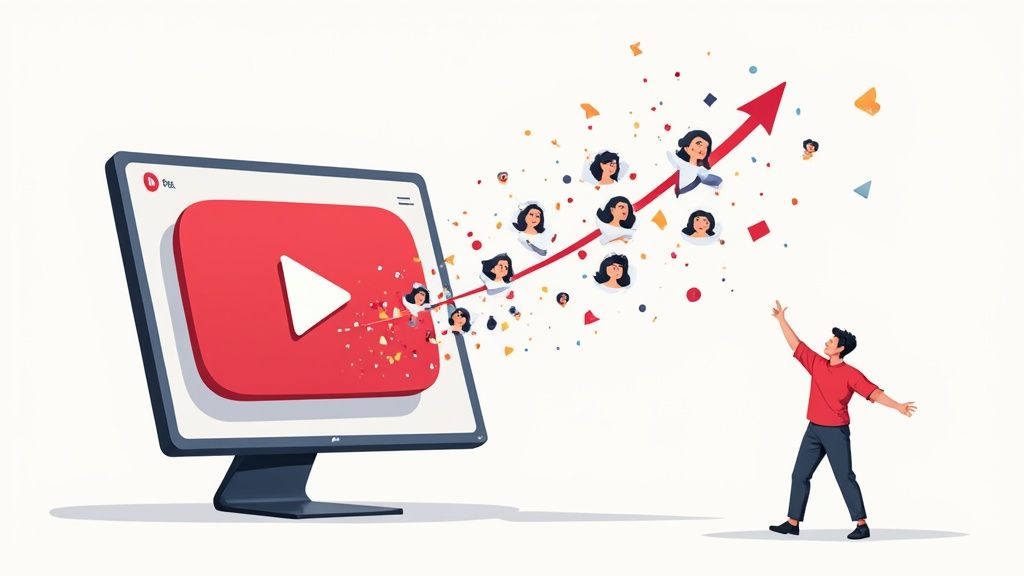How to Generate B2B Leads A Founder's Guide

Before you even think about sending that first cold email or launching an ad, you have to lay the groundwork. A solid B2B lead generation strategy starts with a clear blueprint. It’s all about getting laser-focused on your ideal customer, picking a smart (and lean) set of tools, and then deciding which channels are actually worth your time.
Getting this foundation right from the jump is what separates the campaigns that flop from the ones that print money.
Building Your B2B Lead Generation Foundation
Trying to generate leads without a solid plan is like building a house on sand. It might look okay for a minute, but it's destined to crumble. For solo founders and small teams with tight budgets and even tighter schedules, getting this foundational stage right isn't just important—it's everything. It’s about making smart, strategic choices now to save yourself a world of pain later.
This all boils down to two things: knowing exactly who you're selling to and having the right tools to reach them efficiently.
The whole process really flows from one logical step to the next: define your customer, build your tech stack, and then pick your outreach channels.

As you can see, everything starts with the customer. Nail that first, and the tactical outreach stuff becomes infinitely easier.
Defining Your Ideal Customer Profile
Knowing who you’re targeting is, without a doubt, the most critical piece of the entire B2B lead gen puzzle. A well-defined Ideal Customer Profile (ICP) is so much more than just basic company info. It forces you to get brutally specific about the real-world, bottom-line problems your product actually solves.
A truly effective ICP gets granular on:
- Firmographics: The basics—industry, company size, annual revenue, and where they're located.
- Technographics: What software are they already using? Are they a Salesforce shop? Do they live in Slack? This context is gold.
- Pain Points: What business challenges are keeping them up at night? What metric are they desperately trying to move?
- Buying Triggers: What events signal they might need a solution like yours right now? Think a new funding round, a key executive hire, or a public complaint about a competitor's product.
Mapping this out is the difference between a vague target like "we sell to marketing agencies" and a precise one: "we sell to 10-50 person marketing agencies in North America that use Brevo for email and are struggling with campaign reporting." That level of detail makes every other step in this playbook ten times more effective.
Assembling Your Lean Tech Stack
For a small team, the best tools aren’t the ones with the most features; they’re the ones that are ruthlessly efficient and play nicely together. The goal is a streamlined workflow that kills repetitive tasks and gives you clean data, all without a monster price tag.
A well-chosen tech stack is a massive force multiplier for a small team. It handles the grunt work so you can spend your time on what actually matters: building relationships and closing deals.
Here’s a simple but powerful stack to get you started:
- CRM & Email Automation: A tool like Brevo is perfect. It rolls CRM and marketing automation into one, letting you manage contacts, track deals, and send automated email sequences from a single platform. Ideal for a lean setup.
- Prospecting & Data Enrichment: You need accurate contact info, period. Apollo is a beast for building verified lists of contacts that perfectly match your ICP and gathering key intel on their company.
- Landing Page Builder: When you run a campaign, you need somewhere to send people. A simple builder like Leadpages lets you spin up high-converting landing pages in minutes, no developer needed.
This trio gives you the core engine to find, engage, and manage leads without overcomplicating things. And make no mistake, this process is critical. Research shows that 50% of marketers see lead generation as their absolute top priority. With companies generating an average of 1,877 leads per month and spending around $198 per lead, an efficient, well-oiled machine isn't just a nice-to-have—it's a financial imperative.
To give you a clearer picture, here's a breakdown of the most common channels and what to expect from them.
Essential B2B Lead Generation Channels
This table summarizes the heavy hitters in the B2B world, what they're best for, and the kind of effort you'll need to put in to see real results.
| Channel | Primary Use Case | Effort Level |
|---|---|---|
| Cold Email | Direct, scalable outreach to highly targeted ICPs. | Medium |
| LinkedIn Outreach | Building relationships and targeted messaging. | Medium |
| Content & SEO | Attracting inbound leads by solving problems. | High (Long-term) |
| Paid Ads (PPC/Social) | Generating immediate traffic and leads for specific offers. | Medium to High |
| Referrals | Leveraging existing relationships for warm introductions. | Low to Medium |
| Partnerships | Tapping into another company's audience. | High (Relationship-based) |
Choosing the right channel depends entirely on your ICP, your offer, and your resources. Don't try to do everything at once. Pick one or two channels where you have an edge and focus on mastering them before you expand.
Mastering Outbound Prospecting That Gets Replies
Alright, you've figured out who to target. Now, it's time to actually go get them. Outbound prospecting is your engine for proactively generating leads, but it's as much an art as it is a science. The days of blasting generic templates are long gone; today's game is about starting real conversations with smart, personalized outreach.
This isn’t about spamming inboxes. It’s about a multi-touch approach that combines targeted emails with strategic LinkedIn engagement to show your prospects you’ve actually done your homework.
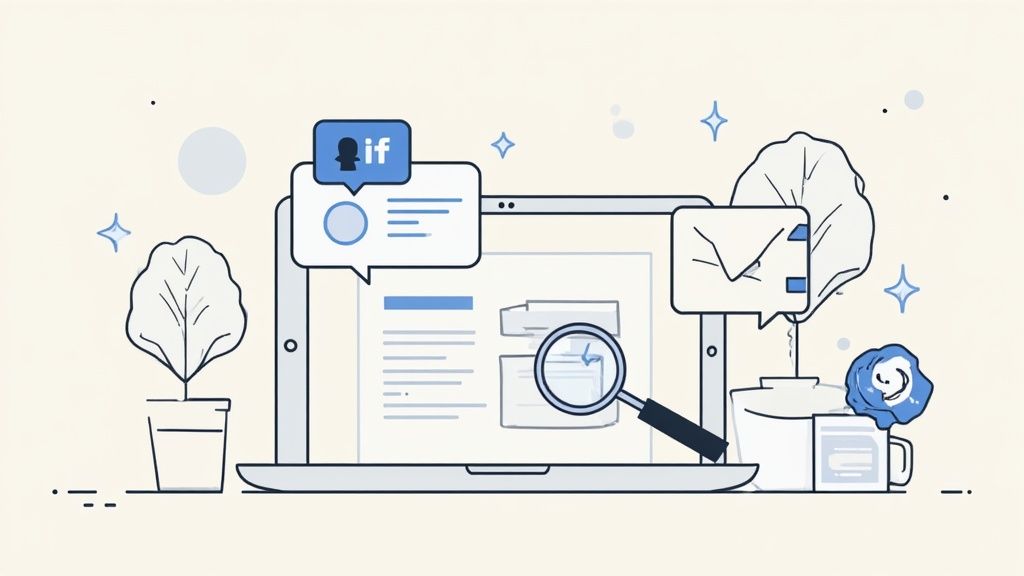
Platforms like Apollo are the backbone of this whole process. They let you build hyper-targeted lists based on your ICP criteria and then find verified contact info, making sure your messages actually land in the right place.
The Power of LinkedIn for B2B Leads
When it comes to B2B, LinkedIn is just in a league of its own. It's so much more than a professional network; it's a goldmine of context and conversation starters—exactly what you need for effective prospecting.
The data backs this up. LinkedIn is a powerhouse, proving 277% more effective for lead generation than other major social platforms. A staggering 89% of B2B marketers lean on it specifically for leads, and its native Lead Gen Forms can pull in conversion rates five times higher than a typical landing page. It's an absolutely essential channel in your outreach strategy.
So, instead of sending another bland connection request, try these moves:
- Engage First: Find a prospect's recent post and leave a thoughtful comment before you even think about connecting.
- Reference Shared Content: Mention a post they engaged with or a group you're both a part of. It instantly creates common ground.
- Use Automation Wisely: Tools like PhantomBuster can handle the grunt work of finding relevant profiles, but your final message should always have that human touch.
Crafting Sequences with the SMYKM Principle
The heart of modern outbound is the "Show Me You Know Me" (SMYKM) principle. It’s about moving past generic personalization tokens like and proving you genuinely understand the prospect's world.
This means building an outreach sequence—a series of timed emails and LinkedIn touches—where every step feels relevant and adds value. You can manage and automate these campaigns with a tool like Lemlist, which is built for creating these kinds of personalized, multi-channel sequences. For a deeper dive, check out our guide on creating effective Apollo outreach sequences.
A great outreach message doesn't talk about your product's features. It talks about the prospect's problem, using language and context that proves you've done more than 30 seconds of research.
Before you send a single email, though, you must nail your deliverability. Services like Bouncer are critical for verifying your email list. Cleaning your list prevents bounces, protects your sender reputation, and ensures your carefully crafted messages actually reach the inbox. Don't skip this step.
Real-World Personalization Examples
Let's make the SMYKM principle tangible. Here’s how you can turn simple research into a compelling message that actually gets replies.
Scenario 1: The New Executive Hire
- Trigger: You spot on LinkedIn that your target company just hired a new VP of Marketing.
- Bad Outreach: "Hi Jane, Congrats on the new role! I help VPs of Marketing like you with..."
- Good Outreach: "Hi Jane, Saw the announcement about you joining Acme Corp—congrats! Having seen leaders in your position tackle brand repositioning in the first six months, I thought you might find this case study on how we helped [Similar Company] do just that useful."
Scenario 2: The Company Funding Announcement
- Trigger: Your target startup announces a Series A funding round on TechCrunch.
- Bad Outreach: "Hey Mark, Saw you raised funding. My tool can help you scale."
- Good Outreach: "Hey Mark, Congrats to the team on the Series A! That's huge. Scaling the sales team post-raise is always a key challenge. I put together a short checklist for founders on prioritizing their first GTM hires—thought it might be timely."
See the difference? The "good" example in each scenario offers immediate, relevant value without asking for anything in return. It starts a conversation based on their world, not yours. This thoughtful, personalized approach is how you cut through the noise and generate B2B leads who actually want to talk to you.
Building an Inbound Funnel That Attracts Your ICP
Outbound gets you in the door, but a smart inbound strategy is what builds the house. While cold outreach delivers those crucial short-term wins, your long-term, scalable growth engine is an inbound funnel that works for you 24/7.
This is how you build a system where your best customers find you, often right when they’re actively searching for a solution.
The core idea is simple: you trade value for attention. Instead of interrupting prospects, you attract them with genuinely useful content that solves a small, specific piece of a larger problem they're wrestling with. This instantly positions you as a helpful expert and builds trust long before you ever ask for a sales call.
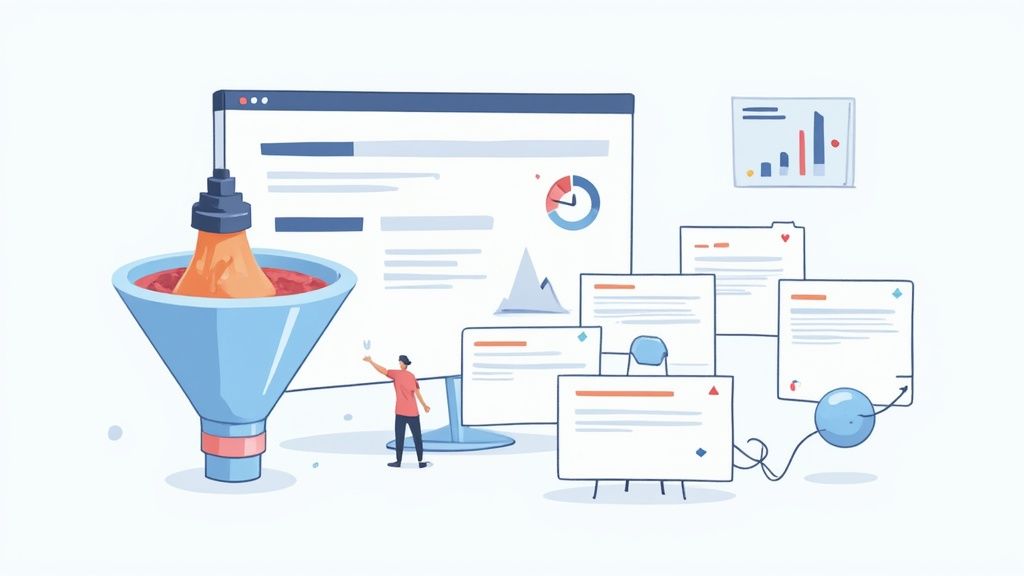
This approach completely shifts the dynamic. You're no longer a cold interruption but a valuable resource they discovered on their own terms. That transition is everything when it comes to building a sustainable B2B lead machine.
Creating High-Value Lead Magnets
The heart of any inbound funnel is the lead magnet. This is just a piece of high-value, downloadable content you offer in exchange for an email address. But a great lead magnet isn't a 50-page ebook; it's a practical tool that delivers a quick win for your Ideal Customer Profile.
Think utility and specificity. Your goal is to solve an immediate, nagging problem for them, right now.
Here are a few powerful lead magnet ideas that just work for B2B:
- Checklists: A step-by-step checklist for a complex process. Think "The 10-Point Pre-Webinar Launch Checklist."
- Templates: A ready-to-use spreadsheet or document. For instance, "The Ultimate Content Calendar Template for Solo Founders."
- Mini-Guides: A short, focused guide that goes deep on one specific topic, like "A Founder's Guide to Writing a Compelling Job Description."
- Resource Libraries: A curated list of the best tools or articles for a particular niche.
The key is making sure the lead magnet is directly related to the service you sell. Someone who downloads a template for tracking sales outreach is a much warmer lead for a CRM consultant than someone who grabs a generic business plan.
Driving Traffic with Foundational SEO
A brilliant lead magnet is pointless if no one can find it. This is where search engine optimization (SEO) comes in. You don't need to be a technical wizard to get results—you just need to focus on creating content that answers the questions your ICP is actually typing into Google.
Start by mapping out the problems that lead someone to need your product. If you sell project management software for agencies, your potential customers are searching for things like "how to manage client projects" or "best agency project workflow."
Your content strategy should be a direct reflection of your customer's pain points. Every blog post, guide, and template should be an answer to a question they are actively asking.
Tools like Frase are invaluable here. They help you analyze what top-ranking pages are covering for a specific keyword, so you can create content that's more thorough and helpful. This data-driven approach takes the guesswork out of what to write.
For a deeper look into the fundamentals, you can learn more about how to do search engine optimization yourself in our complete guide. It’ll give you a solid foundation for driving consistent, high-intent traffic to your offers.
Designing High-Converting Landing Pages
Once a prospect clicks a link, they need a dedicated place to land. A landing page is a standalone web page designed for one single purpose: getting the visitor to take one specific action. In this case, it’s downloading your lead magnet.
Effective landing pages are ruthlessly focused. They're distraction-free, which usually means no navigation menu or links to other parts of your site.
Here’s a simple structure for a landing page that converts:
- A Compelling Headline: Clearly state the benefit of the lead magnet. What outcome will they get?
- A Clear Sub-headline: Add a bit more context and explain what the offer is.
- Benefit-Oriented Bullet Points: List 3-5 key benefits. Focus on the result, not just the features.
- A Simple Form: Only ask for what you absolutely need—usually just an email address.
- A Strong Call-to-Action (CTA): Use clear, action-oriented text on your button, like "Download the Checklist" instead of a boring "Submit."
Platforms like Unbounce or Leadpages make this process incredibly simple. They offer proven templates and drag-and-drop builders, so you can launch a professional, high-converting landing page in under an hour without writing a single line of code. This is the final piece that connects your great content to your lead capture system, creating an automated funnel that generates B2B leads while you sleep.
Right, so your outbound and inbound efforts are humming along, building that long-term, sustainable pipeline. But sometimes, you just need to step on the gas. When you're after immediate, high-intent leads, the most direct path is to tap into existing audiences through partnerships and paid ads.
This isn't about burning cash for flashy metrics. It's about surgically targeting your Ideal Customer Profile where they already hang out, giving you a powerful shortcut to qualified B2B leads right now.
Tapping into Established Audiences with Partnerships
One of the fastest ways to build trust and reel in leads is to borrow it from someone who already has your ideal audience's ear. Strategic partnerships let you get in front of a warm, relevant group of potential customers without having to build that audience from scratch.
This could be as simple as co-hosting a webinar with a non-competing software company whose product plays nicely with yours. Or you could set up a referral program with a well-connected consultant in your niche.
The whole game is about finding a partner whose audience is a dead ringer for your ICP.
- Identify Complementary Businesses: Look for companies that sell to the same customer but aren't direct competitors. Think of a project management tool partnering with an accounting software firm—it just makes sense for the end user.
- Find Industry Influencers: Who are the respected consultants or content creators your ICP follows? A joint webinar or even a mention in their newsletter can send a wave of high-quality traffic your way.
- Propose a Win-Win Scenario: When you reach out, make it painfully obvious what's in it for them. Offer to co-create killer content that their audience will love, or put a generous referral commission on the table.
A good partnership gives you instant credibility and opens the door to an engaged audience, saving you months of work.
Demystifying B2B Paid Advertising
Paid ads, especially on platforms like LinkedIn, are a potent way to get your message directly in front of your ICP with scary precision. Forget about broad, spray-and-pray campaigns. As a founder, your goal is targeted, efficient spending that generates a real, measurable return.
LinkedIn Ads are the go-to here because you can target people by job title, company size, industry—even specific skills they list on their profile. This lets you put your best lead magnet directly in front of the decision-makers you need to reach.
Think of paid ads not as a massive expense, but as a highly controlled experiment. You're paying for data—to quickly learn what message and offer resonates most with your ideal customer, then scaling what works.
This approach requires a smart budget. The cost efficiency of B2B lead generation can be all over the place. Big enterprises might drop $349 per lead on broad campaigns, but smaller, more nimble companies can get that down to an average of $47 per lead just by being more targeted. Channels like online retargeting can be even cheaper, averaging just $31 per lead, proving that smart, focused spending pays off. You can explore more lead generation cost benchmarks to see how these numbers stack up.
Launching Your First LinkedIn Ad Campaign
Getting a LinkedIn Ad campaign off the ground doesn't need to be a huge production. The most effective way to start is by promoting a high-value lead magnet using LinkedIn's native Lead Gen Forms. These forms are a game-changer because they pre-fill with a user's profile info, which slashes friction and sends conversion rates through the roof.
Here’s a simple game plan to launch your first campaign:
- Define Your Objective: In LinkedIn Campaign Manager, pick "Lead Generation" as your campaign goal. Simple.
- Set Your Targeting: Use your ICP criteria to build a tight audience. Start narrow—target by job title, industry, and company size to make sure you’re only paying to reach the right people.
- Choose the Ad Format: A "Single Image Ad" is perfect to start. Use a compelling visual and crisp copy that screams the core benefit of your lead magnet.
- Create Your Lead Gen Form: Keep the form dead simple. Ask only for the absolute essentials: name, work email, and company name. Don't get greedy.
- Set a Realistic Budget: Kick things off with a modest daily budget, maybe $25-$50 per day. That’s more than enough to gather initial data without risking your shirt.
- Measure and Iterate: Keep a close eye on your Cost Per Lead (CPL). Once you have a campaign that’s reliably bringing in leads at a cost you can live with, you can confidently start turning up the ad spend.
Nail Your Lead Management and Follow Up
Getting a steady flow of leads is a huge win, but that's only half the battle. The real work—and where you actually make money—is in the follow-up. A messy or non-existent process for handling new leads is one of the quickest ways to let great deals slip right through your fingers. It’s a surprisingly common problem, too. A staggering 85% of B2B marketers point to lead generation as their top struggle, which almost always bleeds into how they manage the leads they do get.
This is where you shift from just collecting names to actually converting them. It’s all about having a system to quickly spot your best opportunities, nurture the rest, and track everything so you know what’s working and what’s not.
Use a Qualification Framework to Prioritize Your Time
Let's be real: not all leads are created equal. Some are ready to talk business right now, while others are just kicking tires. Spending your prime selling hours on the tire-kickers is a recipe for burnout and missed targets. This is exactly why a simple qualification framework is a founder's best friend.
One of the most effective and straightforward ones is BANT:
- Budget: Can they actually afford what you're selling?
- Authority: Are you talking to the person who signs the checks, or at least someone who has their ear?
- Need: Do they have a real, painful problem that you can solve?
- Timeline: Are they looking to make a move soon?
You don't need to interrogate every new contact with this list on the first call. Think of it as a mental checklist that guides your conversations and your own research. If a lead ticks all four boxes, they're a hot priority. Drop what you're doing and give them your full attention.
A simple framework like BANT stops you from chasing dead ends. It’s a filter that makes sure your most valuable resource—your time—is spent on deals that have a real shot at closing.
Craft a Follow-Up Sequence That Actually Adds Value
Once a lead is qualified, it's time to follow up. The goal here is to be persistent, not annoying. You want to stay on their radar by providing value with every single touchpoint. A generic "just checking in" email is a complete waste of everyone's time.
Instead, map out a simple multi-touch sequence that uses different channels and offers genuinely helpful stuff.
Here's an example follow-up timeline:
- Day 1 (Immediately): Shoot over a personalized email confirming their interest. Briefly remind them of the value and suggest a clear next step. Something like, "Would a 15-minute call next week be helpful to dig into [their specific goal]?" works great.
- Day 3: Send a LinkedIn connection request with a short, personal note that references your email. You're not pitching again; you're just opening another line of communication.
- Day 7: Follow up with an email containing a legitimately useful resource. This could be a relevant case study, a blog post that tackles a common objection, or a template that helps them solve a small part of their problem.
- Day 14: Try a warm call or send one last value-packed email. If you still hear crickets, it's time to move them to a long-term nurture list, like your monthly newsletter.
This kind of structure keeps you top-of-mind without coming off as pushy. It positions you as a helpful expert, not just another salesperson trying to hit a quota.
Track the Metrics That Actually Matter
You can't improve what you don't measure. To figure out if your lead generation efforts are really paying off, you need to track a few key numbers. Forget about drowning in massive spreadsheets; just focus on the metrics that directly impact your bottom line.
These are the essentials you should be watching:
- Lead-to-Opportunity Rate: What percentage of your new leads are actually qualified and become real sales opportunities? This tells you a ton about your lead quality.
- Cost Per Qualified Lead (CPQL): How much time and money are you spending to generate one BANT-qualified lead? This helps you calculate the true ROI of your campaigns.
- Sales Cycle Length: How long does it typically take to get a lead from first contact to a closed deal? Knowing this makes your revenue forecasting way more accurate.
You don't need a complex dashboard to get going. A simple setup in a tool like Notion can do the trick. In fact, you can learn more about streamlining your sales process with Notion in our guide. Having one central spot to see your numbers ensures you know which channels and tactics are driving real results, letting you double down on what works and ditch what doesn't.
Answering Your B2B Lead Generation Questions
Look, diving into B2B lead generation always brings up the same handful of questions. How long until I see something happen? How much is this going to cost me? And what does "good" even look like?
Getting straight answers is key to setting expectations you can actually meet and building a plan you'll stick with. So, let's tackle the big ones I hear from founders and small teams all the time.
How Long Does It Take to See B2B Lead Generation Results?
This one's a tale of two different speeds, and it all comes down to the channels you pick.
If you go the outbound route—think targeted cold email sequences using a tool like Lemlist or direct LinkedIn outreach—you can see the first sparks fly fast. We're talking initial conversations and replies within the first few days or weeks. These are your short-game plays, designed for proactive, immediate engagement.
On the flip side, inbound strategies like SEO and content marketing are the long game. You're building an asset, not just running a play. It typically takes a solid 3-6 months to build enough authority and start ranking for keywords that pull in a steady stream of leads.
The smartest approach? Do both. Secure some quick wins with outbound to get the ball rolling while you patiently build your inbound engine for the future.
What Is a Good B2B Lead Conversion Rate?
Conversion rates are all over the map, so context is everything. Don't get hung up on a single magic number. For a standard website landing page, you're usually looking at a 2-5% conversion rate. If you're hitting that, you're in the ballpark.
But some channels are just built differently.
Take LinkedIn Lead Gen Forms. I've seen these consistently hit 10-15% conversion rates. Why? Because LinkedIn pre-fills the user's info, slashing the friction to almost zero. It’s just easier for people to say yes.
But here’s the thing: the metric that really matters is your lead-to-customer conversion rate. For a B2B professional services firm, that might be as high as 4-5%. For a SaaS product, it could be closer to 1-2%. The real lesson here is to obsess over lead quality, not just quantity.
How Much Should I Budget for B2B Lead Generation?
For a solo founder or a small team just starting out, your biggest initial investment isn't cash—it's your own time. A huge chunk of your "budget" is just good old-fashioned sweat equity. Carve out consistent time for organic LinkedIn posts, engaging in comments, and writing content that solves real problems for your ideal customer. That's your foundation.
When you're ready to dip your toes into paid ads, a starting budget of $500-$1,000 per month for a super-targeted LinkedIn Ads campaign is a realistic place to start. That's enough to get real data without breaking the bank.
Your essential tools, like Apollo for finding contacts or Lemlist for sending emails, have affordable plans that won't kill a lean budget. The absolute non-negotiable? Track your Cost Per Lead (CPL) and Cost Per Acquisition (CPA) like a hawk. Don't even think about spending more until you know you're getting a positive return on your investment.
